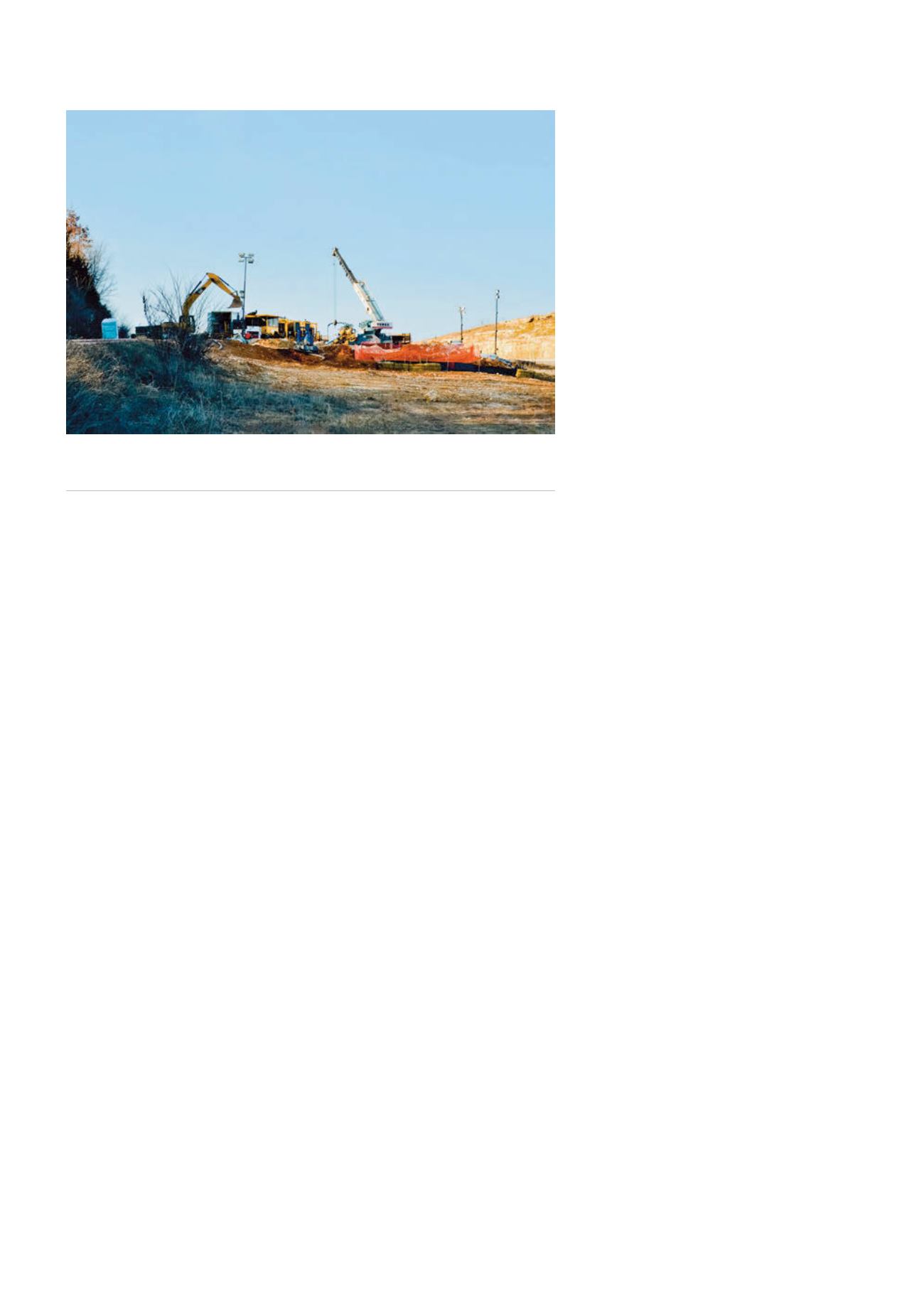
service to potential new customers – the Summit project
involves installing more than 2 million ft (609 600 m) of
6 in. (15.2 cm) HDPE natural gas pipe through some of the
densest rock found anywhere in the US. When complete,
this extensive pipeline network will provide natural gas
to the towns of Gravois Mills, Laurie, Sunrise Beach,
Camdenton, Osage Beach and Lake Ozark, Missouri.
More than 30% of the pipeline – approximately
600 000 ft (182 880 m) – is being installed by horizontal
directional drilling (HDD) technology. The largest and
most costly components of the Summit project – three
trenchless bores beneath the lake at sites alongside the
three major bridges in the area: the Community Bridge,
Hurricane Deck and Niangua – were also the most visible
and challenging. Lone Star Directional Drilling, based in
Clarksville, Texas, was selected by general contractor
J.F. Construction Services, based in DeWitt, Missouri, to
complete the bores. John Dagenhart, founding partner of
Lone Star Directional Drilling and a 20-plus year veteran
of HDD, explains the rationale for selecting the Vermeer
D1000x900 Navigator® horizontal directional drill for the
challenging lake-crossing bores.
“We’re using the D1000x900 drill for many reasons,”
Dagenhart says. “For a maxi drill, the D1000x900 drill is
a relatively easy system to operate…and it’s powerful.
The drill is also very durable and reliable, which is
important given the complexity and the length of the
three lake crossings. We knew the D1000x900 drill had
the capabilities to effectively power through the rock. But
because of the intricate complexity of the lengthy bores,
accuracy and durability are also critical.”
High visibility; strict tolerances;
environmental sensitivities
Dagenhart recalls the first visit he made to the lake with
Jim Frock, founder of J.F. Construction Services, to survey
the new Summit project installation route.
Among the many objectives of the trip was
to identify launch sites with enough area to
accommodate the drill and various support
equipment necessary for completing the
three lake crossings as specified in the drill
plan.
“Finding launch sites with enough flat
area in close proximity to where we’d be
drilling was a challenge,” Dagenhart says.
“There are few areas of flat space desired
for launch sites because the steep terrain
is prevalent right up to the lake’s edge.
All three bores were also situated near or
alongside bridges, where the depth of the
water averages from 90 ft (27.4 m) to more
than 100 ft (30.5 m). Since we were required
to maintain a 40 ft (12.2 m) clearance, the
bores needed to reach a depth of 150 ft
(45.7 m) very quickly; a challenging feat given
the proximity of the launch sites to the
lake’s edge.”
The first bore, completed alongside the Niangua
Bridge, consisted of a continuous 3500 ft (1066.8 m)
shot that took just less than a month to complete.
The second was a 3600 ft (1097.3 m) shot located near
the Community Bridge. Just completed, the third and
final lake crossing was a 6000 ft (1828.8 m) bore near
Hurricane Deck where, coincidentally, a new bridge was
also being built.
“Construction of the new bridge, along with concerns
levied by the bridge construction contractor involving the
demolition of the old bridge, prompted an alteration to the
tolerance,” Dagenhart says. “The specified tolerance on that
bore was increased to 100 ft (30.5 m). As a result, the bore
near the Hurricane Deck Bridge required reaching a depth
of 278 ft (84.7 m) quickly.
A 9 7/8 in. (25.1 cm) chisel bit with tungsten carbide
inserts was chosen for all three bores. “We’ve found that
once we encounter rock in excess of 6000 psi (413.7 bar),
depending on the pipe we’re installing, bits with tungsten
carbide inserts will last longer,” Dagenhart says. “This was
important on a bore of this length, beneath the lake, that
we not have to pull back and change a worn bit before
completing the shot. Experience told us this was the type
of bit we needed to use.”
In addition to the limited space for establishing a launch
site and strict tolerances required in the drill plan, the hard
rock – much of which is fractured in gravel, cobble and
some limestone – presented additional challenges for the
Lone Star drill team. Given the tough conditions, Dagenhart
has been pleased with the average daily production rates
by the D1000x900 drill of approximately 300 ft (91.4 m)
per day. “If we can average 10 pipe joints a day, we’re very
happy,” he says.
Back reams were not necessary on the first bore,
although, on the Community Bridge crossing, where the
drill plan specified 8 in. dia. (20.3 cm) steel pipe versus the
Figure 2.
Lone Star Directional Drilling works on three trenchless bores on the
Summit project near the Lake of the Ozarks. The three bores are located beneath
the lake at sites alongside three major bridges in the area.
118
World Pipelines
/
JUNE 2015


